How PageRank Works - Page Rank Flow Diagrams
In a branch of mathematics called probability distribution, Page Rank seeks to find the probability of picking a particular page out of the billions of pages in the world wide web. Because the world wide web is a network linkage of pages, a page to fully benefit, that page should link-out and link-in to another page. This therefore means that if for example we assume there are only 100 pages in the entire world wide web and you have a site of only one page, then the probability of picking your one page equals 1 divided by 100 - which is equal to 0.01. Since the probability of picking each an every page in the entire world wide web is the same, you have the option of adjusting the probability of picking certain pages at the expense of other pages by linking-in and linking-out with other pages. And that is the whole game about page ranking.
For simplicity, every page that you create is allocated a value of 1 (one) provided it link-out and link-in to other pages in the network. By using a mathematical equation, which is beyond the scope of this article, we are to create two pages without linking them as shown in figure 1 below. If you have a site of ten pages, the total value for your site is ten and the average value per page is 10 divided by 10 equal 1. The Page Rank in this hub should not be confused by the values in the Google toolbar because the scales are different.
1. Let's now look at figure 1 below. The PR value shown for each page is 0.15 and the average is 0.15. But the value should be 1 for each page and an average of 1. The values are lower because we are not linking-out and linking-in.

2. Let's now look at figure 2 below. Here we link page A to page B. The PR value shown for page A is 0.15 and PR value for page B is 0.28. The average value is 0.22. By linking A to B, the PR value of B has increased from 0.15 to 0.28, and the average site value has increased from 0.15 to 0.22. After linking-out to B, the PR value of A has remained at 0.15. These values are still below 1 because the linking-out and linking-in is incomplete - you can go into B but how do you get out of B?

3. Let's now look at figure 3 below. Here we link page A to page B and page B to A. The PR value shown for page A is 1.0 and PR value for page B is 1.0. The average value is 1.0. By linking A to B and B to A, the PR value of B has increased from 0.28 to 1.0, the PR value of A has increased from 0.15 to 1.0 and the average site value has increased from 0.22 to 1.0. These values are now 1 because the linking-out and linking-in is complete - you can go into B, you can get out of B, you can get into A and you can get out A. This therefore represents what the ideal network should be linked like. That out of the billions of pages in the world wide web you should be able to navigate into each an every page and be able to come back to the starting page. If you have a page that you can navigate into and are unable to navigate out, then that is a dead end and there is a price to pay for it.
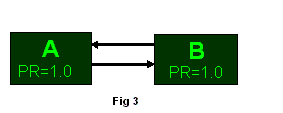
4. Let's now look at figure 4 below. Here we have four pages in our site. We want to capitalize on increasing Page Rank on some pages at the expense of the others. We already know that the higher the number of pages in a site, the higher the total Page Rank for the site. We link A to B and B to A. We link A to C and C to A. We link B to C and D to C. There is no link into D so you can not be able to navigate into page D, and because of that, D has a low PR of 0.15. Pages A, B and C are well linked because you can be able to navigate in and out of pages A, B and C. But the PR in A is higher and PR in B is lower. Why? This is because C is getting some direct powers from D which B is not getting, so the PR of C has to be higher than the PR of B. By why then should the PR of A be greater than PR of C? This is because A is getting direct powers from C without sharing it out with any other page, whilst in case for C, C is getting direct powers from B which is being split between C and A. The average PR for this site is 1 which is good.
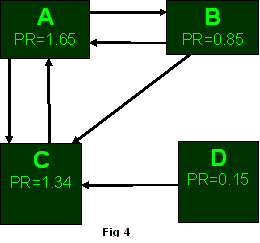
5. Let's now look at figure 5 below. The average PR for the site is 1; the links are well done such that you can navigate in and out of every page. The PR has also been distributed in favour of page A which has PR 2.38. This site has a good linkage. You are required to note the values for the next step in fig 6.
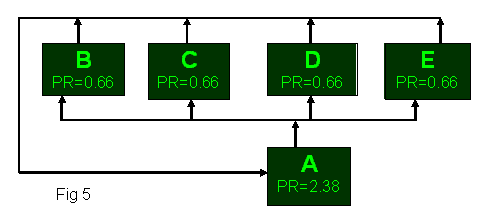
6. Let's now look at figure 6 below. From our good site in fig 5 above, we add the so-called outbound links from page E to site F, G, H and I. What happens? The average PR drops from 1 to 0.61 - a staggering 39 per cent drop just because of a simple outbound linking! How many of us are doing that to our sites without knowing? You are required to note these PR values for the next step in fig 7.
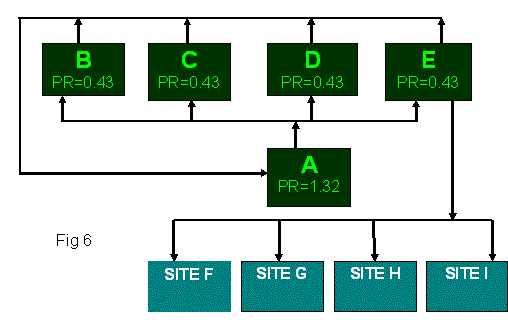
7. Let's now look at figure 7 below. We start by assuming that PR of the pages in sites F, G, H and I is 0.75, 0.50, 0.25 and 0.25 respectively. Let's now get the so-called back linking or inbound links from pages F, G, H and I into our page A. What happens? The average PR increases from 0.61 to 1.91 - a staggering 214 per cent rise! How many of us are doing that to our sites?
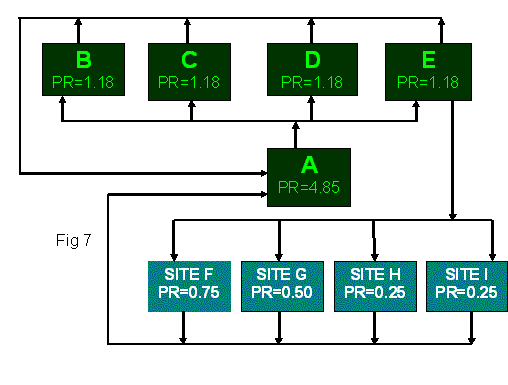
The Page Rank in these Page Rank Flow Diagrams should not be confused by the values in the Google toolbar because the scales are different.
And what have we learnt here in this hub? There are a number of things we have learnt here and if you want you can list them for you to have. But one thing that is certain is: what Google is doing today will be different from what it will do tomorrow. However, they will continue to insist on good quality context, quantity of context in a site, originality, no spamming, good linking, keyword density, keyword frequency, page rank, average site page rank and so on and so forth. The first page of Google search engine's results can only have ten to twenty sites at any one time out of millions of sites that would want to be on that front page. Building sufficient page rank is difficult for the small marketer. And even when you can build it the competition is stiff and the winners of the front pages are always the winners - you may wish to win the marathon but if the race has ten thousand competitors, then the chances of you winning are as good as zero.
The future in internet marketing for the average person has more to do with social networking sites like hubpages where there are high chances of your page being seen by other community members. When we pull together in a social site like hubpages, we can be able to build a surprisingly high PR for hubpages which will always rank high in Google front pages - and by the same logic, that will in turn be good to you and me. The bottom line is: link out from your hub but always make sure you get more back links to your hub - the benefits are huge as we saw in our illustration of Page Rank Flow Diagrams above.
The Author’s page is designed to help beginners and average readers make some money as an extra income to supplement what they may be earning elsewhere - details of which you can find in My Page, if you will.








